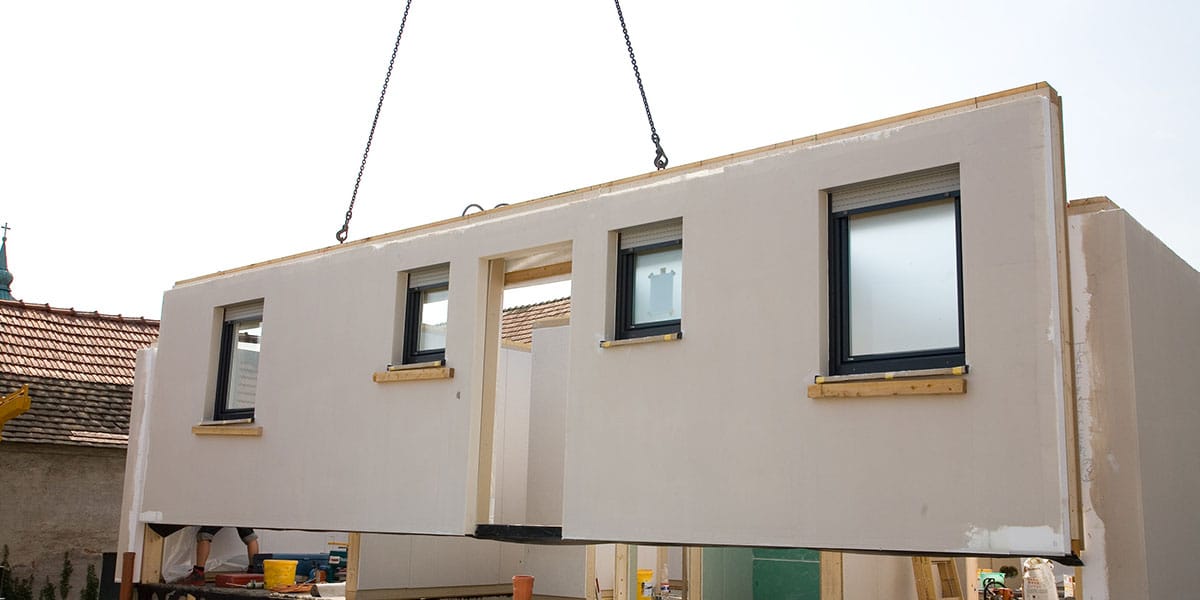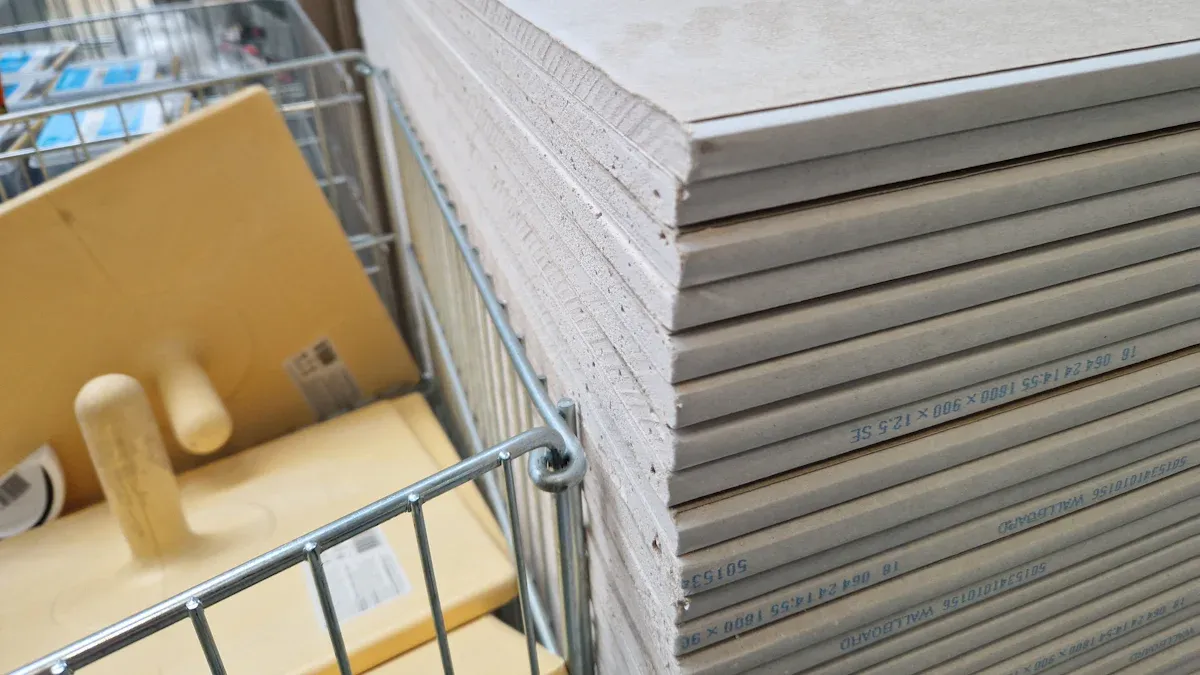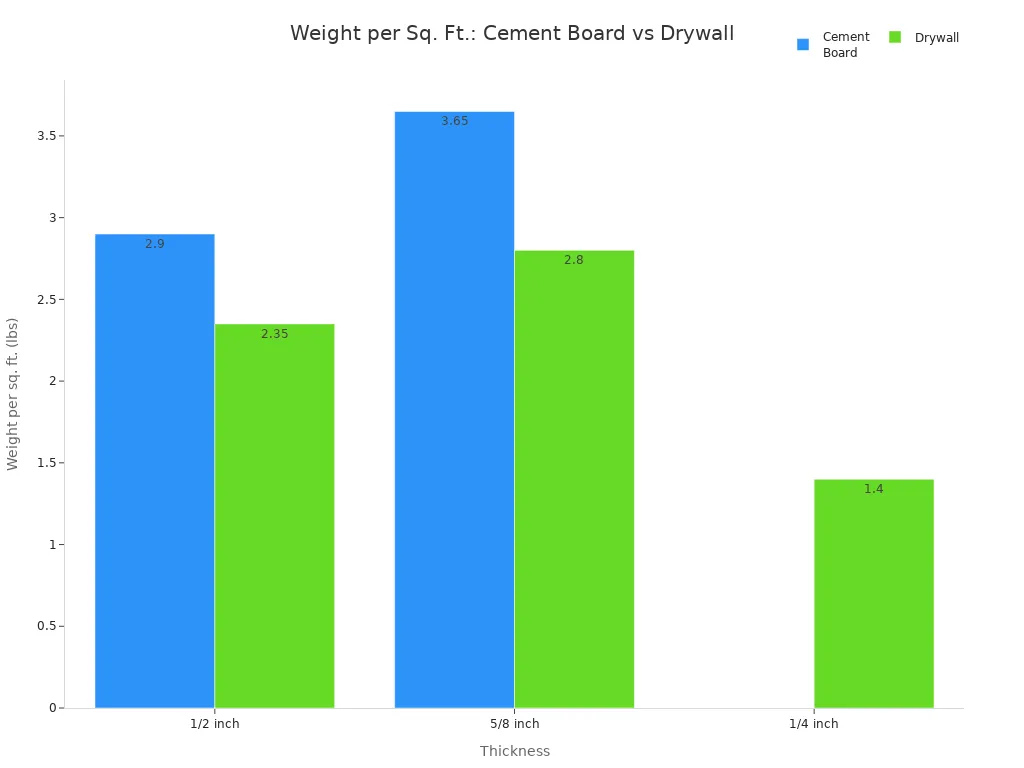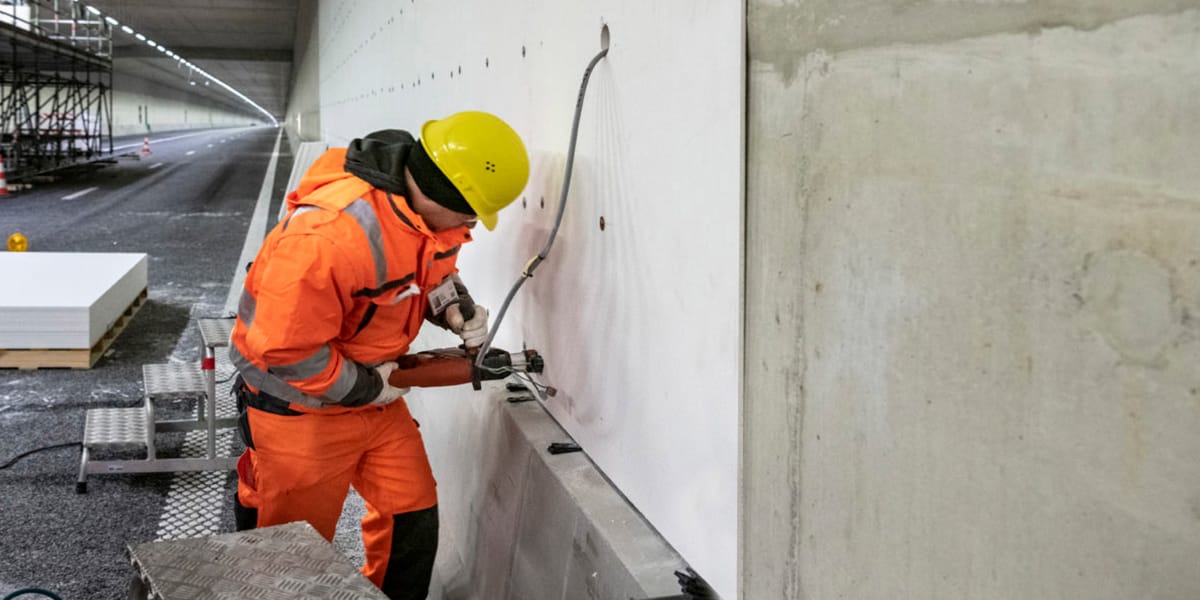
10 Aug Cement Board vs Drywall Which Is Right for Your Home
Table of Contents
You want your walls to last, so choosing the right material matters. Cement board works best in wet or moisture-prone spaces like bathrooms, showers, and some kitchens. Drywall fits dry, interior rooms such as living rooms and bedrooms. When you plan your project, think about how much moisture the area gets, how durable you need the walls to be, and your budget. Cement board resists water and mold because it contains no organic material, making it a reliable choice for areas that see a lot of moisture.
Key Takeaways
Pick cement board for wet places like bathrooms and kitchens. It stands up to water, mold, and fire better than drywall.
Use drywall in dry rooms like living rooms and bedrooms. It gives a smooth surface that is easy to finish. Drywall is also cheap and fast to put up.
Cement board is heavier and harder to put in. It costs more at first but lasts longer. It also needs fewer fixes in tough spots.
Drywall is lighter and easier to put in. It costs less but can get ruined by water. It also needs more fixing over time.
Always choose the right material for each room. This keeps your home safe and saves money. It also helps make your home comfy and strong.
Quick Comparison
At-a-Glance Table
If you need to pick between cement board and drywall, it helps to see the main differences fast. The table below shows both materials side by side. This makes it easier to choose what works for your project.
Criteria | Cement Board | Drywall |
|---|---|---|
Moisture Resistance | Waterproof, resists mold and water damage | |
Durability | Strong, impact-resistant, stands up to heavy use and tile | Less durable, can get damaged by moisture or impact |
Cost | Lower price (about $8 per 4’x8′ sheet); moisture-resistant types cost more ($12-$17) | |
Installation | Harder to install, heavy, needs special tools and often professional help | Easy to install, lightweight, DIY-friendly, uses basic tools |
Best Use Cases | Bathrooms, kitchens, showers, exterior walls, tile backers, fire-prone areas | Living rooms, bedrooms, dry interior spaces, easy finishing |
Appearance | Rough surface, not for painting or finishing | Smooth surface, easy to paint and finish |
Weight and Thickness | Heavier and thicker sheets (3’x5′) | Lighter, larger sheets (4’x8′) |
Tip: If you want to put up tile or expect lots of water, cement board is the best choice. For most dry rooms, drywall is cheaper and faster to use.
Cement board is made from cement and fiberglass mesh. This makes it very strong and hard. It works well in wet places or where people walk a lot. It costs more and is harder to put up, but it lasts longer where you need tough walls. Drywall is made from gypsum and paper. It is lighter and easy to cut. You can put it up fast, and it gives a smooth wall for paint or decorations. Some drywall types can handle some water, but they are not as strong as cement board.
Always pick the right material for each room. Use cement board in bathrooms and kitchens. Use drywall in living rooms and bedrooms. This quick guide helps you pick the best one for your home.
Cement Board
What Is Cement Board
Cement board is a tough material for places that get wet. It is made by mixing cement, cellulose fibers, and silica sand. First, these things are mixed with water to make a thick paste. The paste is shaped into flat sheets. The sheets are dried and made ready to use. Some companies add chemicals to make it stronger. The finished board is thick and can handle water and heavy use.
Pros
Cement board has many good points:
You do not need to do much to keep it nice, so you save time and money.
It does not burn easily and keeps out water, bugs, and rot, so it works well in bathrooms, kitchens, and outside.
It is very strong, so you can use it for floors, walls, and ceilings.
It does not bend or fade in bad weather.
It can look like wood or come in many colors and styles.
It is good for the earth because it uses natural and recycled things and is made in a way that does not pollute much.
You can cut and shape it easily to fit your design.
Note: Cement board often gets an A1 fire rating and does not have asbestos, so it is safe for your home.
Cons
Cement board also has some bad sides:
It costs more than drywall or vinyl.
It is heavy and hard to put up, so you may need help and special tools.
You cannot recycle it, which is not good for the earth.
It can break if you do not handle it carefully.
You need to paint or seal it often to keep it looking good.
Bad weather like hail, wind, or heat can make it wear out faster.
Cutting it makes dust, so you must wear safety gear.
Drywall

What Is Drywall
Most new homes use drywall for walls and ceilings. Drywall is made from gypsum, which helps stop fires and keeps heat in. Workers crush and heat the gypsum to dry it out. Then, they mix it with things like starch, glue, and sometimes fiberglass. This mix becomes the middle part of the drywall. Workers put this core between two thick sheets of paper. The paper is often recycled. The panels are baked in ovens, cut to the right size, and checked to make sure they are good. This makes drywall light, smooth, and easy to paint.
Drywall is popular because it is simple to use. You can cut it with a knife and attach it with screws or nails. The paper outside makes it easy to paint or put up wallpaper.
Pros
Drywall has many good points for homes and businesses:
Affordable: Drywall costs less than most other wall choices, so you save money.
Quick Installation: You can put up drywall faster than plaster, so jobs finish sooner.
Energy Efficiency: Drywall helps keep rooms warm or cool, which can lower bills.
Fire Resistance: The gypsum inside slows down fire, so your home is safer.
Moisture and Mold Resistance: Some drywall types stop water and mold, so walls stay safe in damp places.
Professional Look: Drywall gives a flat, neat wall that looks nice with paint. 7. Versatility: You can use drywall for soundproofing, curved walls, or special designs.
Builders like drywall because you can recycle it and it is good for the planet.
Cons
Drywall also has some problems you should know:
Water can ruin drywall, so you might get mold and need to replace it.
Nails or screws can pop out if not put in right, making bumps.
Cracks can show up if your house moves or if joints are not finished well.
Tape on the joints can come loose, especially if not installed right.
Corners can get dents or cracks from bumps and need fixing.
Bad measuring or finishing can make your walls look or feel wrong.
Some drywall from other countries has caused health and rust problems, but this is rare.
To have strong, trouble-free walls, install drywall the right way and pick the best type for each room.
Comparison
Moisture Resistance
You need strong moisture resistance in bathrooms, kitchens, and laundry rooms. Cement board stands out in these areas.
Magnesium oxide boards, a type of cement board, absorb less than 1% moisture. They keep almost all their strength after repeated wet and dry cycles. Mold does not grow on them in lab tests.
Drywall absorbs water quickly. It swells, crumbles, and loses up to half its strength after getting wet several times. Mold grows easily on drywall, especially after water damage.
Even moisture-resistant drywall cannot match the water and mold resistance of cement board.
In field and lab tests, cement board keeps its shape and strength, while drywall often needs replacement after water exposure.
For wet or humid spaces, you should always choose cement board. It keeps your walls safe from water and mold.
Durability
Aspect | Drywall | Cement Board |
|---|---|---|
Prone to dents, scratches, holes | Superior durability, resists physical damage | |
Moisture Resistance | Vulnerable to moisture damage, mold growth | Excellent moisture, mold, and mildew resistance |
Long-term Durability | Prone to cracking, warping, higher maintenance | Longer lifespan, stable in wet environments |
Maintenance Costs | Higher due to frequent repairs | Lower due to durability and minimal repairs |
Installation Cost | Lower upfront cost | Higher upfront cost but cost-effective long-term |
You will notice that drywall gets dents and holes easily, especially in busy areas. Cement board resists damage from bumps and impacts. It lasts much longer, especially in places with lots of moisture. You spend less on repairs over time with cement board. Drywall needs more frequent fixes and does not last as long.
Installation
 . You need special tools to cut and fasten it. The material is heavy and brittle, so you must handle it with care. Cutting cement board creates dust, so you need to wear protective gear.
. You need special tools to cut and fasten it. The material is heavy and brittle, so you must handle it with care. Cutting cement board creates dust, so you need to wear protective gear.Drywall is lighter and easier to cut. You can use a utility knife and basic tools. Most people can install drywall quickly, making it a good choice for DIY projects.
Cement board installation often requires a professional, while drywall is more beginner-friendly.
If you want a fast and simple installation, drywall is the better option. For wet areas, the extra effort with cement board pays off in the long run.
Cost
Material | Cost Per Square Foot (2024) | Installation Labor (per sq ft) | Total Installed Cost (per sq ft) |
|---|---|---|---|
Drywall | $2.00 – $4.00 | ||
Cement Board | $1.50 – $3.00 | $2.00 – $4.00 | $3.50 – $7.00 |
Drywall costs less to buy and install. You pay more for cement board, both for the material and the labor. However, cement board lasts longer and needs fewer repairs, which can save you money over time.
Repair
You can repair drywall quickly with patch kits or joint compound. Small holes and dents are easy to fix.
Water-damaged drywall often needs full replacement. The paper and gypsum weaken, and mold can grow.
Cement board resists water and impact damage, so you repair it less often. When you do need to fix it, the process is more involved. You must cut out the damaged section, tape and mud the seams, and sometimes re-tile the area.
Cement board repairs take more time and skill but provide better long-term results in wet or high-traffic areas.
For quick and easy repairs, drywall is best. For lasting repairs in tough spots, cement board is worth the effort.
Weight
Material | Thickness | Handling and Installation Impact | |
|---|---|---|---|
Cement Board | 1/2 inch | ~2.9 lbs | Heavier, needs more effort to handle |
Cement Board | 5/8 inch | ~3.65 lbs | Heaviest, may require extra help |
Drywall | 1/4 inch | 1.3 – 1.5 lbs | Lightest, easy to carry and install |
Drywall | 1/2 inch | 2.2 – 2.5 lbs | Common, manageable for most people |
Drywall | 5/8 inch | 2.6 – 3 lbs | Heavier, may need two people |

You will find that cement board is heavier than drywall. This makes it harder to lift and install, especially on ceilings or large walls. Drywall is lighter and easier to move, which speeds up installation.
Fire Resistance
Cement board does not burn. It blocks flames and keeps its shape during fire exposure. Its high thermal mass slows the spread of heat to other areas.
Drywall is not flammable, but it crumbles faster under fire. Fire-rated drywall (like 5/8″ Type X) is designed to last longer in a fire, but the fire rating depends on the whole wall assembly, not just the drywall itself.
Building codes require tested and certified assemblies for fire resistance. Cement board can be part of a fire-rated wall, but you must follow manufacturer instructions and local codes.
For the best fire protection, use certified fire-rated assemblies. Cement board adds extra safety, especially in areas where fire risk is higher.
Best Uses
Bathroom
You need strong protection against water in bathrooms. For showers, tubs, and other wet spots, cement board works best. It does not swell, rot, or break down when wet. You can use it as a base for tile, and it resists mold. Remember, cement board is not a vapor barrier, so you may need a waterproof layer behind it. Always use corrosion-resistant screws and special tape for the joints. Moisture-resistant drywall is easier to handle but does not last as long in wet areas. You should avoid regular drywall in showers or near tubs.
Cement board is ideal for:
Shower walls and floors
Bathtub surrounds
Steam rooms
Moisture-resistant drywall works for:
Bathroom ceilings
Dry areas away from direct water
Tip: Store cement board flat and handle it with care to prevent cracks.
Kitchen
Kitchens often face splashes and steam. You want a wall that can handle both. Use cement board behind sinks, stoves, and anywhere you plan to install tile. It stands up to water and heat. For dry walls and ceilings, drywall is a good choice because it is easy to finish and paint.
Area | Recommended Material | Reason |
|---|---|---|
Backsplash/Tile | Cement board | Water and heat resistance, tile support |
Sink/Range Area | Cement board | Handles moisture and heavy use |
Dry Walls/Ceilings | Drywall | Smooth finish, easy to install |
Always wear a dust mask and goggles when cutting cement board.
Living Room
You want your living room to look great and last a long time. Most people choose drywall for its smooth surface and easy painting. It gives a clean, modern look. If you want something different, wood and cork offer warmth and sound control, but they need more care. Microcement is another option for a seamless, modern style. It is tough, waterproof, and easy to clean. Drywall remains the most popular for living rooms because it balances cost, looks, and comfort.
Bedroom
Comfort and air quality matter most in bedrooms. Drywall is a common choice because it is affordable and easy to finish. You can improve indoor air by picking eco-friendly wallboards and low-VOC paints. These options help you create a healthy space. Drywall works well in bedrooms if you keep moisture away. It also stands up to daily use and gives you a cozy, quiet room.
Choose eco-friendly drywall for:
Better air quality
Long-lasting walls
A comfortable, restful space
Exterior
For outside walls, you need strength and weather protection. Cement board stands out here. It resists fire, water, and mold. It does not crack or warp easily and can last for many years. You can paint or cover it with stucco. Some people prefer other finishes for looks, but cement board gives you peace of mind in tough weather. Drywall does not work outside because it cannot handle moisture or temperature changes.
Cement board advantages:
High durability
Moisture and fire resistance
Supports heavy finishes
Cement board disadvantages:
Harder to install
Fewer style options than brick or siding
For exterior walls, always pick materials that protect your home from water and fire.
You need different walls for each room. Bathrooms and kitchens get wet, so pick something that stops water. These rooms also need walls that last a long time. Living rooms and bedrooms are dry, so you want walls that are easy to put up. You also want them to look smooth and nice. Look at this table to help you choose:
Factor | Best for Wet Areas | Best for Dry Areas |
|---|---|---|
Bathrooms, kitchens | Living rooms, bedrooms | |
Durability | High-traffic, wet spots | General use |
Installation | Professional help | DIY-friendly |
Cost | Higher | Lower |
Think about what matters most to you. Picking the right wall means your home will last longer and you will worry less.
FAQ
Can you paint cement board?
You can paint cement board, but you need to use a primer first. The surface feels rough, so choose paint made for masonry or cement. Always follow the manufacturer’s instructions for best results.
Is moisture-resistant drywall good for showers?
Moisture-resistant drywall does not work well in showers. It absorbs water over time and can grow mold. You should use cement board for shower walls and other wet areas.
How do you cut cement board safely?
You should use a carbide-tipped scoring tool or a circular saw with a masonry blade. Always wear a dust mask and safety glasses. Cutting cement board creates a lot of dust.
Tip: Cut cement board outdoors if possible to keep dust out of your home.
Can you install tile directly on drywall?
You can install tile on drywall in dry areas, such as kitchen backsplashes. For wet areas, like showers or tub surrounds, always use cement board as the tile backer. This prevents water damage and mold.

 . You need
. You need